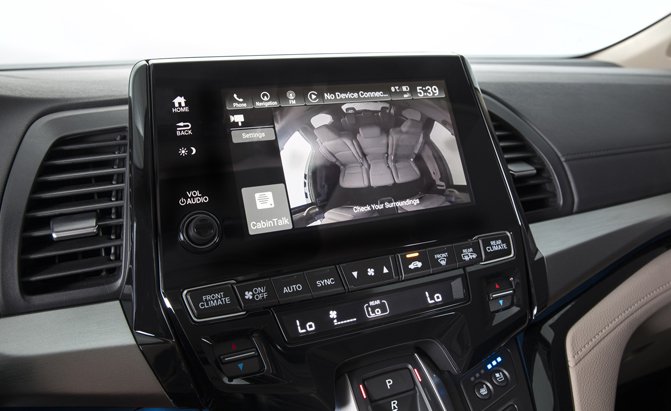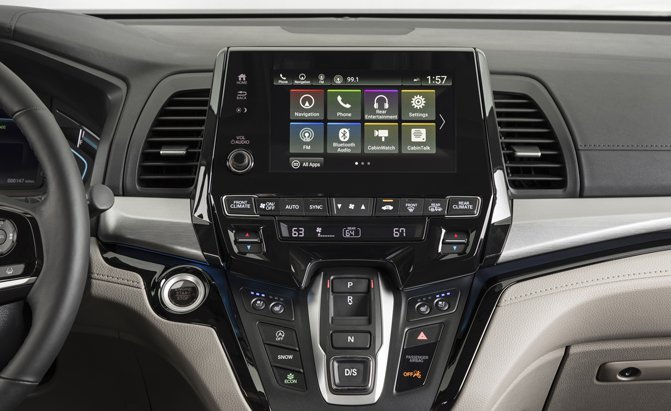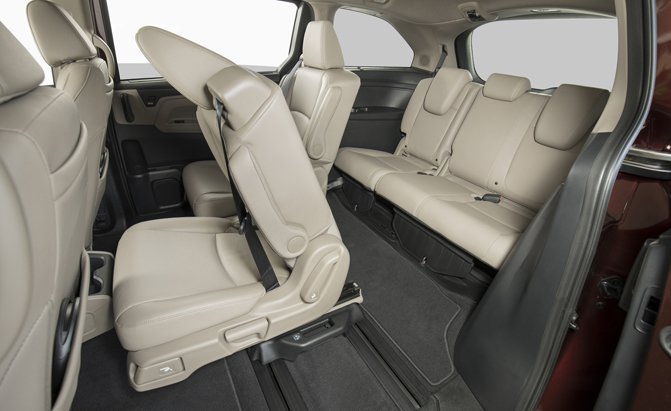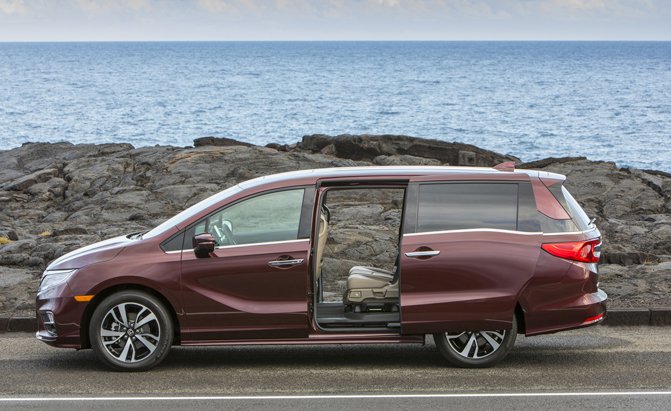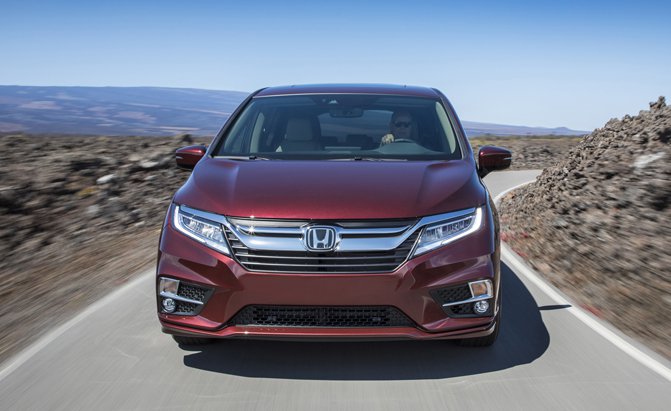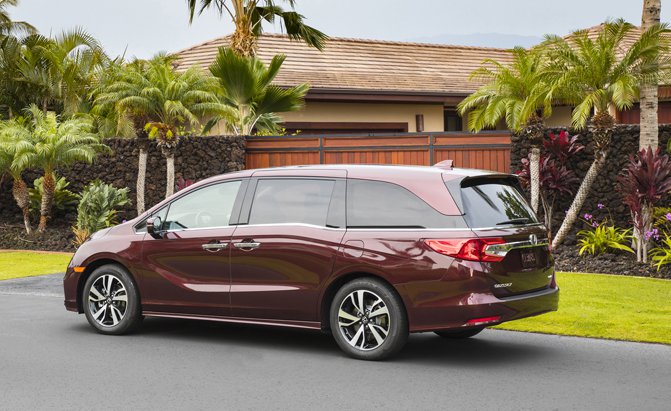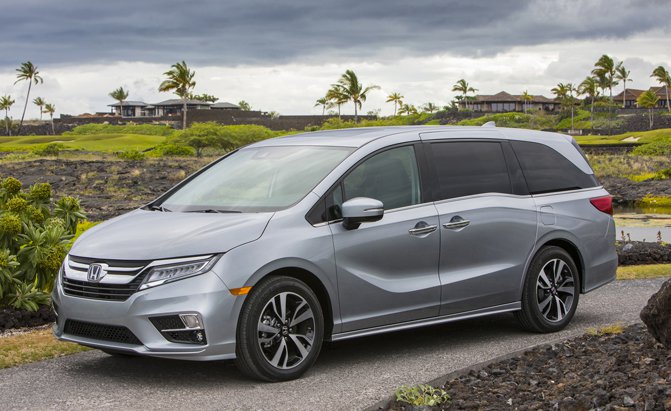“I don’t want to drive a big-bum minivan.”
Those are the exact words from my wife’s mouth when I suggested we buy a Honda Odyssey.
Despite her comments, she and I can be considered members of the minivan appreciation society. Over the years, they’ve been our go-to road trip vehicles from the local fleet of cars to review, opting only for an SUV or large crossover when no vans were available. And every single time we drove a van, we were thankful, regardless of which automaker made it.
SEE MORE: 2017 Kia Sedona vs 2017 Hyundai Santa Fe
And yet, when it comes to actually owning one, there’s still some stigma. So can the obvious advantages of a minivan overcome the drawbacks? I needed to find out because my family and I are legitimately about to pull the trigger on buying either an Odyssey or a Pilot in the next few weeks.
So, of course, when I got the chance to be one of the first people in the world to review the new Odyssey, a test that involved bringing my whole family to the Big Island of Hawaii, I jumped at the opportunity. There just couldn’t be a better test case than my family of four.
New Interior Has Fantastic Technology
Prior to driving the Odyssey, we had pretty much settled on the Pilot. The previous Honda Odyssey just couldn’t compete when it comes to safety, technology, and convenience features. But most of all, it has just aged so poorly inside.
The new 2018 model changes all that and adds a few extra features we might not be able to live without. Engineers walked me through pretty much every new trick the Odyssey has added to its repertoire and driving it felt incredibly natural.
Standout features include all the work done to improve sound deadening, from the thicker carpeting, acoustic glass and spray foam, making in-cabin conversation easy — even with our soft-spoken kids (we’re lucky, we know).
SEE MORE: 2017 Chrysler Pacifica Touring L Plus Review
Improving that experience further, Honda has borrowed a trick from Toyota’s playbook, and now offers what it’s calling “CabinTalk.” With the push of a button on the new display screen on the dash, the driver or front passenger’s voice can be projected through the cabin speakers. And to make sure you’ve reached the attention of everyone, it also overrides the car’s headphones for the entertainment system.
For some reason, my kids couldn’t get enough of testing this feature.
This comes combined with the CabinWatch feature. With a camera mounted above the second row, it gives a perfect vantage point to parents as to what their kids in child seats (particularly rear-facing seats) are up to. That said, it really only does seem to be useful for parents of infants.
Getting back to that display screen, at eight inches and standard on all but the base model, it’s hard not to be impressed. Mounted high on the dash, it’s a focal point in the cabin and deserves to be. It looks as modern as the latest smartphone and, shockingly, works just as well.
Automakers continuously promise phone-like interfaces that respond as quickly as we’ve all become used to. And this is a car that finally delivers on that promise. Swipe several times and the screen responds immediately. Plus, if it ever does have issues, Honda will offer over-the-air updates, so you don’t have to bring it in for service. The apps can also be moved from screen to screen by holding and dragging, so you can customize your most popular apps on the first page, just like you’d do with a smartphone.
SEE MORE: All-New 2018 Honda Odyssey Offers Quieter Cabin, 10-Speed Transmission
Taking another technological step forward, there’s now an available Cabin Control App that allows you to adjust the rear heat and A/C, control the rear entertainment system and send destinations from your smartphone to the car’s Nav system. While not new to the industry, it’s nice that it’s standard equipment. In a race to find a destination, smartphones are always faster than in-car Nav. Another advantage of this new app is that second- and third-row passengers can have it as well, and permissions can be given to allow (or not allow) control over certain aspects.
And perhaps most fun is the Social Playlist feature that lets up to seven people send songs from their phones to a queue, so everyone can get a chance to hear their favorite songs — and parents can veto songs they don’t want to hear, or, more likely, songs they don’t want to hear for the 45th time in a row.
On top of all this, the new Honda Odyssey gets Apple CarPlay and Android Auto.
Back Seat Magic
As with every new generation of Odyssey, perhaps the best feature is reserved for passengers.
With the previous generation minivan, Honda introduced its Wide Mode seating functionality that allowed the second-row seats to be pulled apart to make room for three child seats. That concept has now been evolved further with the Magic Slide second-row seats. With the center seat removed, the two remaining captain’s chairs can slide sideways up to 12.9 inches each way – even when child seats are installed. The seats require surprisingly little effort to slide and feature locking positions roughly every three inches.
Designed to allow the best possible access to the third row, parents might agree that the real magic will be on road trips when you can slide the seats together so your kids can entertain each other, and then slide them apart when they start to get on each other’s nerves.
SEE MORE: 2017 Honda CR-V Long-Term Test Update: Road Trip Edition
Another peacekeeping option is the in-car entertainment system. Gone is the 16.2-inch split screen setup from past top-trim Odysseys, as Honda says consumers found it confusing. Instead, there’s a smaller 10.2-inch setup that includes a BluRay player and can run streaming video thanks to an available 4G LTE setup.
In a world of tablets, this setup might seem outdated, but I appreciate the inclusion because one of my kids gets motion sickness from using a tablet in the car, while in-car TV screens have never been an issue.
Living With a Van
Over the course of two days, we really lived with our Odyssey, installing child seats (which was super easy), loading and unloading the trunk with beach supplies, and going on a multi-stop road trip that involved plenty of getting in and out.
Sliding doors continue to be one of the best automotive inventions ever, and my 6- and 8-year-old were hopping in and out with ease. They’ve only ever really known the manual sliding doors of our Mazda5 (or a loaner van) and I’ve seen them struggle to get into and out of SUVs, so it was a welcome sight to watch the ease with which they hopped into and out of the low step-in height of the Odyssey.
Both grown-ups were glad for the addition of the hands-free tailgate that pops open by kicking your foot under the rear bumper (standard on Touring and Elite trims). And backing out of parking spaces, it’s nice that Honda finally added its rear cross-traffic monitor to the Odyssey, a feature that’s been available on the Pilot for two years and had me (until now) leaning in the Pilot’s direction.
Putting the car into reverse takes a little getting used to now, thanks to the unique “trigger” button on the dash (a feature borrowed from the Acura lineup).
Popping it into a forward gear (of which there are now either nine or ten depending on the trim level) is a simple push of the “D” button. More gears help gain another highway mpg compared to the previous version, a disappointingly slim improvement. A modified engine does deliver an extra 32 hp for a total of 280, but I can’t say you ever really notice the difference.
The big van does hustle up to speed reasonably well and certainly never feels lacking for power. And it’s just so smooth and quiet, which, when you consider the price of a fully loaded Odyssey, there’s no reason it shouldn’t feel like a luxury sedan.
With so much glass around you, it’s remarkably easy to maneuver, and my wife, in particular, couldn’t get over how it doesn’t feel all that big when you’re behind the wheel.
One the road, the transmission is remarkably smooth, though the same can’t be said from a start. My biggest complaint with the Odyssey was the considerable clunk our 10-speed tester made (just as often as not) when put into gear. Then there’s the stop-start system, which I’ve begrudgingly learned to live with on modern cars. The off-the-line delay really is an annoyance, though, and a particular gripe of my wife.
Other notable additions for 2018 include available ventilated front seats and wireless charging, plus, finally, a heated steering wheel.
Then there’s the styling. No one buys a minivan to look cool, swagger wagon or not, but the new van is considerably more handsome than the outgoing model. This is, in part, due to the LED daytime running lights on most trim levels, while the top two trims get LED headlights and fog lights. The biggest change to the overall aesthetic is what’s been removed, with the sliding door track now hidden in the design of the windows, rather than being cut across the side of the van’s body.
The Verdict: 2018 Honda Odyssey Review
Driving the 2018 Honda Odyssey didn’t immediately help us make up our mind. In fact, it did the opposite. Two weeks ago, the minivan was pretty much an afterthought, and now it’s forcing us to rethink exactly what we want in a vehicle.
From the TV to the power sliding doors to the ease of access and, yes, CabinTalk, both of my kids are sold.
While it still doesn’t have AWD (a definite reason to opt for a crossover), the styling is no longer a concern. With the latest technology, exceptional (if not downright excessive) cargo room, the latest innovations and, of course, the reliability that makes any Honda so compelling an option, it comes down to the drive.
And as my wife will most certainly get the last say in whatever we choose, it only makes sense to let her have the last say here, too.
“I’ll give the Honda engineers credit. I don’t know how they made that thing not feel like a big-bum van, but it doesn’t.”
Discuss this story at our Honda Odyssey forum







